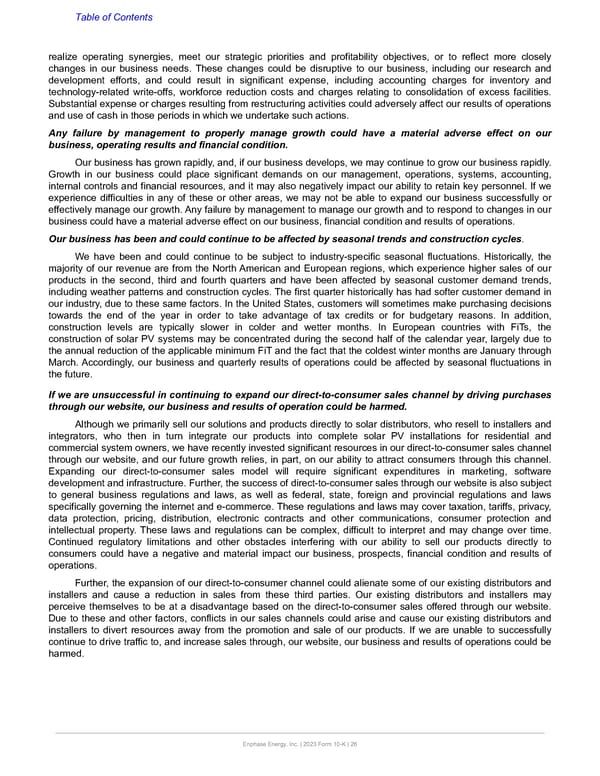Table of Contents realize operating synergies, meet our strategic priorities and profitability objectives, or to reflect more closely changes in our business needs. These changes could be disruptive to our business, including our research and development efforts, and could result in significant expense, including accounting charges for inventory and technology-related write-offs, workforce reduction costs and charges relating to consolidation of excess facilities. Substantial expense or charges resulting from restructuring activities could adversely affect our results of operations and use of cash in those periods in which we undertake such actions. Any failure by management to properly manage growth could have a material adverse effect on our business, operating results and financial condition. Our business has grown rapidly, and, if our business develops, we may continue to grow our business rapidly. Growth in our business could place significant demands on our management, operations, systems, accounting, internal controls and financial resources, and it may also negatively impact our ability to retain key personnel. If we experience difficulties in any of these or other areas, we may not be able to expand our business successfully or effectively manage our growth. Any failure by management to manage our growth and to respond to changes in our business could have a material adverse effect on our business, financial condition and results of operations. Our business has been and could continue to be affected by seasonal trends and construction cycles. We have been and could continue to be subject to industry-specific seasonal fluctuations. Historically, the majority of our revenue are from the North American and European regions, which experience higher sales of our products in the second, third and fourth quarters and have been affected by seasonal customer demand trends, including weather patterns and construction cycles. The first quarter historically has had softer customer demand in our industry, due to these same factors. In the United States, customers will sometimes make purchasing decisions towards the end of the year in order to take advantage of tax credits or for budgetary reasons. In addition, construction levels are typically slower in colder and wetter months. In European countries with FiTs, the construction of solar PV systems may be concentrated during the second half of the calendar year, largely due to the annual reduction of the applicable minimum FiT and the fact that the coldest winter months are January through March. Accordingly, our business and quarterly results of operations could be affected by seasonal fluctuations in the future. If we are unsuccessful in continuing to expand our direct-to-consumer sales channel by driving purchases through our website, our business and results of operation could be harmed. Although we primarily sell our solutions and products directly to solar distributors, who resell to installers and integrators, who then in turn integrate our products into complete solar PV installations for residential and commercial system owners, we have recently invested significant resources in our direct-to-consumer sales channel through our website, and our future growth relies, in part, on our ability to attract consumers through this channel. Expanding our direct-to-consumer sales model will require significant expenditures in marketing, software development and infrastructure. Further, the success of direct-to-consumer sales through our website is also subject to general business regulations and laws, as well as federal, state, foreign and provincial regulations and laws specifically governing the internet and e-commerce. These regulations and laws may cover taxation, tariffs, privacy, data protection, pricing, distribution, electronic contracts and other communications, consumer protection and intellectual property. These laws and regulations can be complex, difficult to interpret and may change over time. Continued regulatory limitations and other obstacles interfering with our ability to sell our products directly to consumers could have a negative and material impact our business, prospects, financial condition and results of operations. Further, the expansion of our direct-to-consumer channel could alienate some of our existing distributors and installers and cause a reduction in sales from these third parties. Our existing distributors and installers may perceive themselves to be at a disadvantage based on the direct-to-consumer sales offered through our website. Due to these and other factors, conflicts in our sales channels could arise and cause our existing distributors and installers to divert resources away from the promotion and sale of our products. If we are unable to successfully continue to drive traffic to, and increase sales through, our website, our business and results of operations could be harmed. Enphase Energy, Inc. | 2023 Form 10-K | 26
 Annual Report Page 25 Page 27
Annual Report Page 25 Page 27